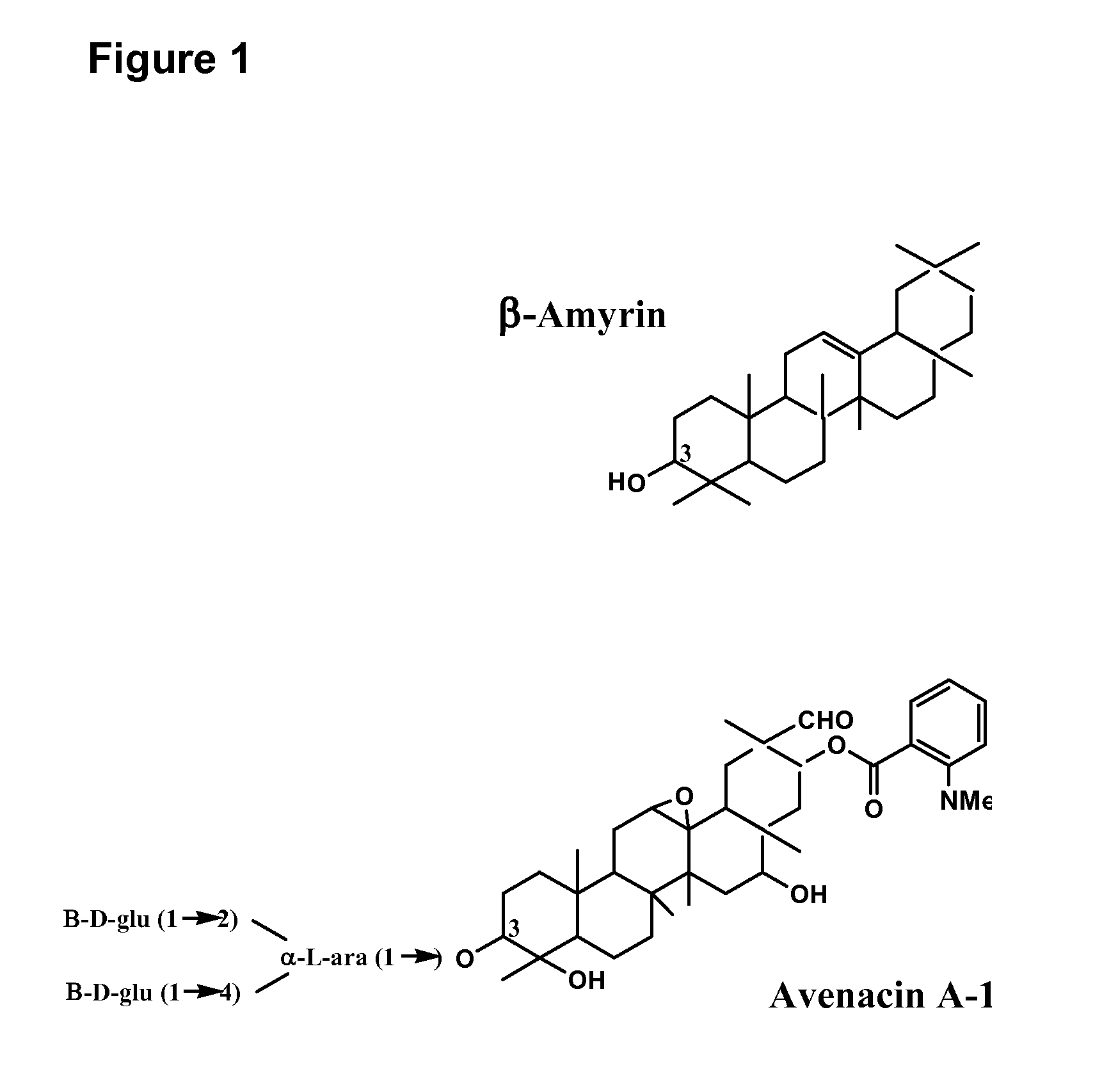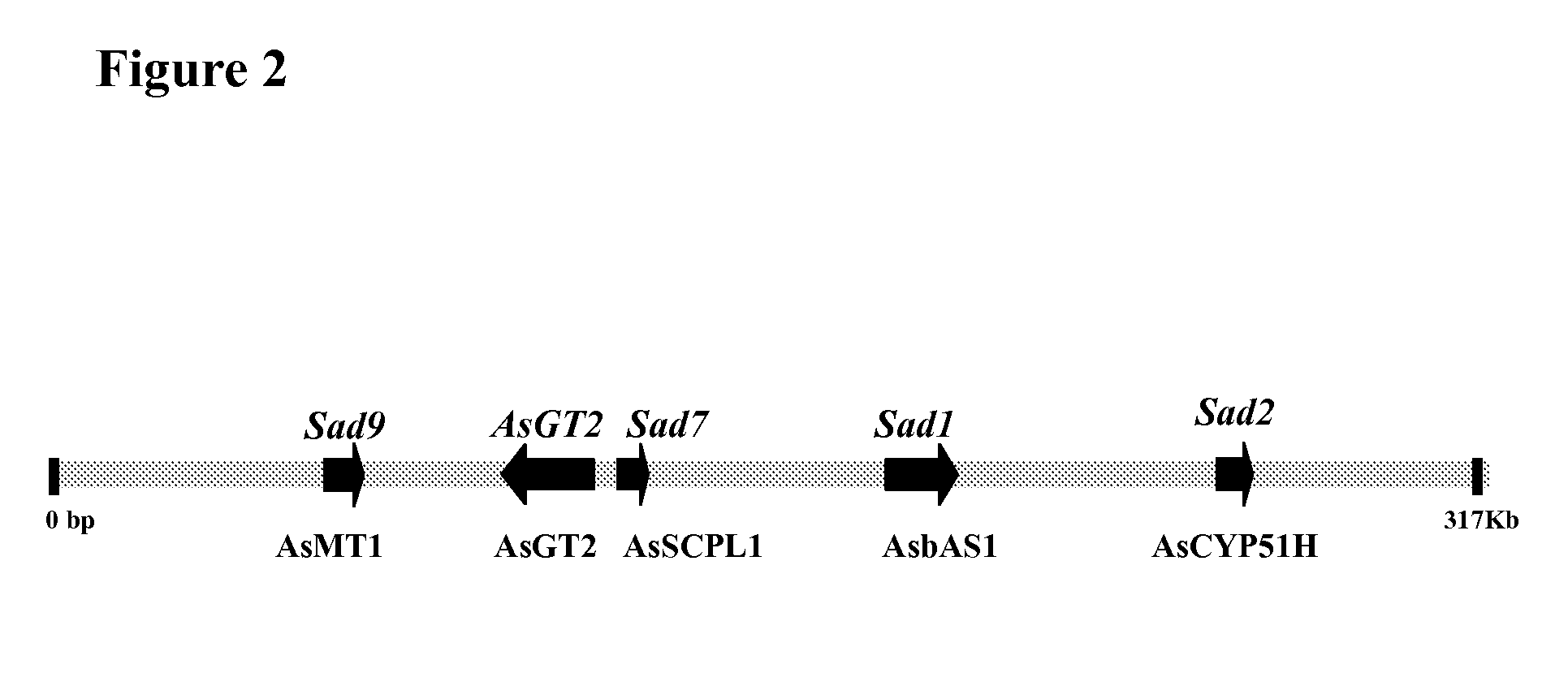Enzymes involved in triterpene synthesis
a triterpene and enzyme technology, applied in the field of plant molecular biology, can solve the problems of uncharacterized gene machinery for the elaboration of this important family of plant secondary metabolites, and achieve the effects of reducing cholesterol, reducing triterpenes, and improving plant resistance to pests
- Summary
- Abstract
- Description
- Claims
- Application Information
AI Technical Summary
Benefits of technology
Problems solved by technology
Method used
Image
Examples
example 1
Isolation of Genomic and cDNA Fragments for the Serine Carboxypeptidase-Like Protein (AsSCPL1), the Methyltransferase (AsMT1) and the Glucosyltransferase (AsGT2)
[0152]The genomic polynucleotide fragment encoding the genes affected in the serine carboxypeptidase-like protein (AsSCPL1), the methyltransferase (AsMT1) and the glucosyltransferase (AsGT2) was isolated from a BAC library derived from Avena strigosa accession S75 genomic DNA and a cDNA library prepared from oat as follows.
[0153]A BAC library was constructed from A. strigosa accession S75 genomic DNA ((Qi X. et al., 2006, Proc. Natl. Acad. Sci. U.S.A 103:18848-18853). DNA probes derived from Sad1 (Osbourn et al. Mar. 6, 2007, U.S. Pat. No. 7,186,884 B2) and Sad2 (Osbourn et al. US 2006-0112448 A1) were used to screen the entire BAC library. A BAC contig spanning a gene cluster for avenacin biosynthesis (Qi X. et al., 2004, Proc. Natl. Acad. Sci. U.S.A. 101:8233-8238) was built. BAC finger printing and BAC end sequence analys...
example 2
Isolation and Characterization of Sad7 Oat Mutants
[0161]Seed of the diploid oat species Avena strigosa were mutagenized with sodium azide and M2 seed from individual M1 plants were germinated and assessed for root fluorescence as a preliminary screen to identify saponin-deficient, or Sad, oat mutants. Candidate avenacin-deficient mutants were identified on the basis of reduced root fluorescence and confirmed by TLC and HPLC analyses of methanolic root extracts from homozygous M3 seedlings.
Generation of Mutants
[0162]Seed of the diploid oat species Avena strigosa (accession S75 from the Institute of Grasslands and Environmental Research, Aberystwyth, Wales, UK) was mutagenized with sodium azide essentially as described (Rines, H. W., 1985, Env. Exp. Bot., 25:7-17). Briefly, mutagenesis was performed as follows. Seeds were presoaked in an Erlenmeyer flask sealed with a rubber stopper using 0.5 ml water per seed while shaking in an orbital platform shaker at 120 cycles per minute. After...
example 3
Isolation and Characterization of Sad9 Oat Mutants
[0167]The original mutants #616, #825, #376 and #1243 (Papadopoulou et al. 1999. PNAS 96 12923-1928) do not contain any nucleotide changes in AsMT1 and AsGT2 genes. Sequence analysis was extended to the 82 new Sad mutants that were isolated as described in Example 2. Three mutant M3 lines (#195, #961 and #1310) were identified as having point mutations in the AsMT1 gene (Table 2). No mutations were identified in the AsGT2 gene for any of the mutants in the collection. DNA sequence analysis confirmed a single nucleotide change in the coding sequences in the three mutants, #195, #961 and #1310. Each of these nucleotide changes is predicted to cause an amino acid change (Table 2).
[0168]Roots of these three mutants lack the bright blue fluorescence associated with avenacin A-1 but fluoresce dull purple fluorescence under UV illumination. These mutants are referred to as “purple mutants”. One more purple mutant #841 was identified from th...
PUM
 Login to View More
Login to View More Abstract
Description
Claims
Application Information
 Login to View More
Login to View More - R&D
- Intellectual Property
- Life Sciences
- Materials
- Tech Scout
- Unparalleled Data Quality
- Higher Quality Content
- 60% Fewer Hallucinations
Browse by: Latest US Patents, China's latest patents, Technical Efficacy Thesaurus, Application Domain, Technology Topic, Popular Technical Reports.
© 2025 PatSnap. All rights reserved.Legal|Privacy policy|Modern Slavery Act Transparency Statement|Sitemap|About US| Contact US: help@patsnap.com



